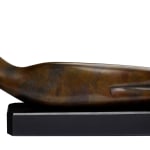



Alexander Archipenko 1887-1964
Further images
Alexander Archipenko, the early twentieth-century Eastern European artist, migrated to the West seeking freedom, economic stability, and artistic success. He first settled in La Ruche, Paris in 1908, joining the esteemed Section d'Or group alongside Marcel Duchamp, Pablo Picasso, and Guillaume Apollinaire. By 1910, Archipenko was exhibiting with the Cubists at the Salon des Indépendants and continued to showcase his sculptures at the Salon d'Automne from 1911 to 1913.
During the First World War, Archipenko relocated from Paris to Nice and began creating sculpto-peintures, a revolutionary form of sculpture influenced by two-dimensional art. He gained recognition for reinterpreting sculpture in relief, solidifying his international reputation. When he arrived in New York in November 1923, Archipenko was regarded by many as the greatest living sculptor.
Archipenko innovatively incorporated negative spaces to dematerialize his round sculptures and depict different body parts. His work primarily revolved around the female form, representing real individuals rather than superficial naturalism. He fused harmony, aesthetic beauty, and spirit in his artistic essence.
Archipenko drew inspiration from various cultural sources, including Byzantine culture, ancient Egyptian art, Gothic art, and primitive art. As a result, his female figures resembled fragmented ancient statues, often lacking heads and limbs while evoking rather than directly describing forms.
Archipenko excelled in imbuing his sculptures with a tangible presence. While he approached abstraction in his pursuit of a timeless representation of women, he avoided complete fragmentation and emphasized the fluidity of forms. Each part of the female subject's body held equal significance, contributing to a clear and organic structure.
The ‘Lying Horizontal Figure’ of 1957 epitomizes Archipenko's artistic vision, resembling his renowned Torso in Space of 1936. This graceful and fluid figure appears to float in space, connected to infinity. This particular cast is a very rare lifetime example. During his life, Archipenko only created 6 impressions of this beautiful bronze sculpture. According to ‘The Archipenko Sculpture Catalogue Raisonné’ published by The Archipenko Foundation, three casts are currently in a Private Collection. Two casts have been untraced by the author. All the posthumous casts are also kept in Private Collections.
Provenance
The Estate of Alexander Archipenko, New York.
With Bernard Danenberg Galleries, New York, 1972.
Private Collection of Donald Karshan, New York. Karshan was the expert on the work of Alexander Archipenko.
With Rachel Adler Gallery, New York.
Private Collection, South Africa.
Private Collection, Australia.
With Annette Larkin Fine Art, Sydney.
Corporate Collection, Australia.
Literature
Coates, R. M., 'The Art Galleries, Shy Leader', The New Yorker, New York, 17 October 1959, p.144 (another example).
Archipenko, A., Archipenko: Fifty Creative Years 1908-1958, Tekhne, New York, 1960, pl.130 (illus., another example)
Karshan, D., Archipenko, Sculpture, Drawings and Prints, 1908-1963, Centre College and Indiana University Press, United States of America, 1985, pl.90a, 90b (illus., another example)
Barth, A., Alexander Archipenkos Plastisches Oeuvre, Peter Lang, Frankfurt, 1997, cat.325, pp.552-553 (another example)
Gray, F. A., My Life with Alexander Archipenko, Hirmer, Munich, 2014, p.92, pl.38 (illus., another example)



